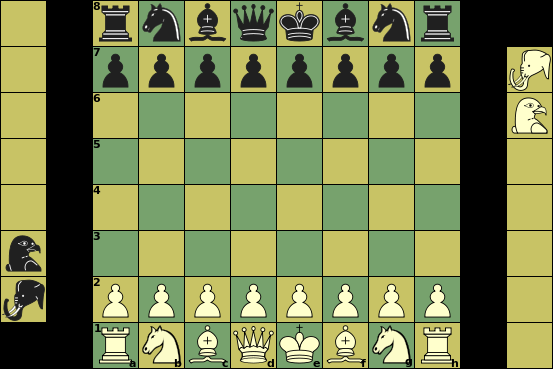Seirawan Chess (S-Chess)

Pieces available for gating will be displayed beside the board |
Initial setupe1, e8: King |
Moves at a Glance
Click on a piece below to see its moves
 |
 |
 |
 |
Sliding capture or non-capture, can be blocked on any square along the ray |
|||||||
 |
Unblockable leap (capture or non-capture) | ||||||||||
 |
 |
Non-capture only | |||||||||
 |
Capture only | ||||||||||
 |
|||||||||||
 |
 |
 |
 |
 |
 |
 |
|||||
 |
 |
||||||||||
 |
 |
:
:
:
:
| Piece | ID | value | Moves (Betza notation) | Remarks |
| King | K | - | K | Can castle with Rook, moving 3 steps towards it |
| Queen | Q | 9.5 | RB or Q | |
| Elephant | E | 9 | RN | |
| Hawk | H | 8.75 | BN | |
| Rook | R | 5 | R | |
| Bishop | B | 3.5 | B | Color-bound |
| Knight | N | 3 | N | |
| Pawn | P | 1 | mfWcfF | Promotes to Q, E, H, R, B, or N on reaching last rank |
Pawn peculiarities
- Pawns capture differently from how they move (straight move, diagonal capture).
- Pawns can move two squares ahead from their initial position, provided they are not blocked.
- On the move immediately after such a double push, they can be captured en passant by another Pawn, as if they had only moved 1 square ahead.
- Pawns promote to any other (non-royal) piece of choice when they reach last rank.
Castling
A King that has not moved before can move three squares in the direction of a Rook that has not moved before, in which case that Rook is moved to the square next to the King on the other side. This is only allowed if all squares between King and Rook are empty, when the King is not in check on the square it came from, and would not be in check on any of the squares it skipped over.
General rules
- It is not allowed to expose your King to check.
- The game is won by checkmating the opponent's King.
- Stalemate (no legal moves, but not in check) is a draw.
- The Elephant or Hawk can be 'gated' into play, by placing them on a square evacuated by a back-rank piece that moved for the first time, as second part of the same turn.
- During gating, your King must not 'pass through check'.
- When castling, you can gate onto the King or Rook square, but not on both.
XBoard interface issues
To perform a gating move, first select the piece to be gated. (When you have not switched off highlighting or the line gap, this will draw a yellow border around the piece.) Then move the piece on the back rank. If you drag the piece, the gated piece will appear from under it. (With click-click moving you will only see it after the move is already done.) To gate on the Rook square after castling, you have to enter the castling by dragging the Rook onto the King!
To enter a gating move by typing, you have to suffix them with /H or /E. For gating on the Rook square after castling, you would have to write the castling as RxK. (Ughh! Good thing that no one in his right mind would want to gate there!)
Differences with FIDE
The Elephant and Hawk pieces are extra, and enter the board by gating.
Strategy issues
It is not possible to force checkmate on a bare King with just a single Bishop or Knight (in addition to your own King). Two Knights cannot do that either. The Archbishop can force checkmate against a bare King.
Bishops are confined to squares of a single color. Having Bishops on both colors compensates this weakness, and is worth an extra 0.5 on top of their added value.
As Elephant and Hawk are nearly equal in value to Queen, under-promotion is very common.
The super-pieces (Q, E, H) devaluate by the presence of lower-valued opponent pieces. As a result trading Q for R + B is in general a good trade when you still have E and H, as the latter gain in value by eliminating the opponent's R and B, which is more compensation than the intrinsic value difference between Q and R + B.
Keeping E and H in hand is good if there are still many gating opportunities, as you can then gate at the location that is most damaging to your opponents position. When there are not too many positions left, protecting the remaining ones becomes a vulnerability, however, so you better use them were you still can. If you still have a piece in hand, and only a single Knight that can gate it (bacause all your other pieces already moved), even sacrificing a Queen for that Knight would gain your opponent a piece.